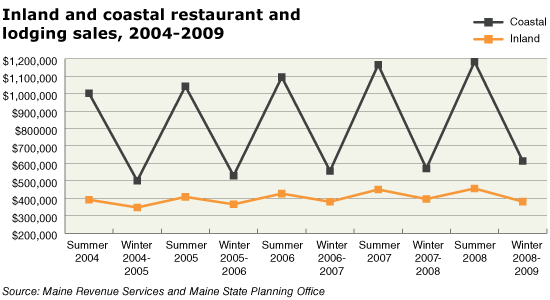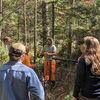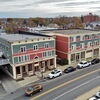Without reservation | Maine's tourism industry needs an aggressive business focus to survive
Maine has long been known as “Vacationland.” And tourism has always been an important player in Maine’s economy. According to the most recent figures from the Maine Office of Tourism, Maine hosts over 6 million overnight trips per year, bringing over 15 million visitors who spend over $6 billion at destinations all across the state. In 2009, jobs in leisure and hospitality numbered 60,000 and generated $1.5 billion in wages.
But is the tourism industry ready for the 21st century? Will Maine’s most widely known industry be the job-engine that leads the state out of the recession?
Today the outlook is grim, but hope remains. “We need to focus on survival,” says Kathryn Weare, owner of the Cliff House in York. The recession has hit the tourism industry hard. Discretionary income has fallen and declining housing prices have made even those who have kept their jobs feel less secure and thus less likely to take vacations. “In 30 years in the business, I’ve never seen it as bad as it was last year,” says Greg Dugal, executive director of the Maine Innkeepers Association. “But,” he adds, “Maine is nowhere near as hard hit as other parts of the country. We’re nowhere near as dependent on air travel as other places. Our one-day car trip market is huge. We’ll be back this year.”
To make that comeback, Maine’s tourism industry needs to focus on three things — product development, extending the seasons and smarter marketing.
Product development
“Our natural resources are our basic advantage,” says Weare. “We need to make them more accessible and provide more things for people to do during their visits.” She cites the Shoreline Explorer trolley line along U.S. Route 1 as a successful example of a public-private partnership aimed at expanding the opportunities for visitor activities close to the beaches. The Cliff House added a full-service spa, as an example of product development.
Matt Polstein, owner of Twin Pines Camps, cites a similar example in the Millinocket region. “Several of the camp owners got together with local snowmobile clubs and municipal officials to work cooperatively to rebuild, re-route and groom trails, prepare maps, create convenient day-long loops and generally improve the sledding experience,” he says. The results have been striking. Even with the lower snowfall this year, Polstein says his January business was up “substantially” over last year. Businesses should identify what they can offer and then develop the surrounding experience through nearby attractions, trail and road maps, adds Polstein.
Another form of product development is increasing value. “People are saving more and using their credit card less,” says Dugal of the innkeepers association. “Everyone wants a deal.” As a result, many places are offering room upgrades, free meals and coupons for shows or shopping.
Product development also means recognizing that visitors to world-class destinations need world-class service. “If our extraordinary natural assets are to translate into good job opportunities, the entire visitor experience, from dining to shopping to filling up the car, must be seen as better than anything else in the regional marketplace,” says Richard Barringer, professor at the University of Southern Maine’s Muskie School of Public Policy and chair of the governor’s Maine Quality of Place Council. This requires equipping the tourism work force with upgraded skills, everything from a friendly smile along with a fierce commitment to customer service to fluency in the new era of digital communication and decision making. “Work force development is the key to turning Maine’s wonderful quality of place and recreational opportunities into a secure and sustainable living for Maine people,” Barringer says. The council was a leading force behind a recently passed bill, LD 1389, that creates a regional quality of place investment strategy for the state. Barringer believes that closer alignment among the Maine Community College System, the University of Maine System and the needs of the tourism industry is needed.
Extend the seasons, the reasons to visit
But what about businesses that don’t own a piece of the Maine coast, and might not boast world-class ocean views? For tourism to be a statewide economic engine, Maine needs to convince visitors that all regions are worth a visit, and during all seasons of the year. Expanding both the seasons and the geography has long been the “holy grail” of the tourism industry. What can make this a reality?
One way to attract visitors to more parts of Maine and during seasons other than summer (or winter, for those centered on snow-dependent activities) is by hosting special events. Harvest on the Harbor, a week-long culinary festival in October, drew 3,000 “foodies” from 25 different states last year to the Portland area. “Our primary goal is to extend the traditional Memorial to Columbus Day season into the ‘shoulder’ season,” says Barbara Whitten, president of the Greater Portland Convention & Visitors Bureau and coordinator of the festival. ”This is something we can do to bring people to Maine when they wouldn’t normally think of coming here.” Harvest on the Harbor also helps introduce visitors to other Maine places. Vendors come from as far away as Twenty 2 Vodka in Houlton and Fieldstone Farms in Bangor.
Most important for attracting visitors inland and after the peak foliage season, however, is to have something exceptional to offer. With Harvest on the Harbor, it’s the fact that Maine is a culinary destination, with two James Beard award-winning chefs at Fore Street and Hugo’s. Three hundred miles north, the Maine Outdoor Center in Millinocket offers people a reason to come to Maine’s North Woods. The unique product they offer — a first-class meal, a comfortable place to stay and a reliable range of activities like snowmobiling, hiking, rafting and moose-watching — attracts visitors year round.“We don’t sell a room,” says Polstein. “We sell an experience.”
Smarter marketing
Creative and effective marketing is also crucial for the industry. And more and more often, that marketing occurs on the web. “The tourism industry is at the forefront of a digital age. All marketing agencies now need social media experts,” says Dugal. Innkeeper Weare agrees, and has added staff to maximize the likelihood that Google searches for lodging on the coast of Maine will display the Cliff House. She notes, “We need to be more Internet-savvy in our marketing.” Facebook, Twitter, blogs and making sure your business appears on sites like Google Maps and Google Local are now key elements of a successful marketing strategy.
But it’s not just marketing, it’s branding too, say tourism insiders. Did you know that Rockland was named one of the “coolest” small cities in 2009 by Budget Travel? Or that Portland was named the “foodiest” small town in America by Bon Appétit? “Getting that message out is critical,” says Whitten, head of Harvest on the Harbor. Last year she hired a public media consultant to think of creative ways to broadcast the event, resulting in more than 150 articles nationwide about the festival.
The need to brand and market world-class recreational opportunities cries out for public-private collaboration, since the entire state benefits from improving the “Maine” brand. The Maine Office of Tourism recently expanded its efforts to include retail marketing to broaden its efforts beyond building awareness and interest, and moving closer toward making the sale as well. “Retail marketing means we will be including something in our communications that creates more urgency to act now, and that influences the decision to choose Maine,” says Pat Eltman, MOT director. The recent “Shop, Dine, and Stay” campaign is an example. The office’s website showcases over 300 vacation packages designed by businesses. “We know that the program has resulted in a significant increase in visitation to our website. And the response from the tourism industry has been overwhelmingly positive,” says Eltman.
21st-century tourists
In the old days, the mom ‘n pop motel on the byway would attract tourists on their way to somewhere else. But visitor preferences are changing. Today, the trends are for “experiential” tourism and destination travel. Certainly some visitors enjoy rustic accommodations where they’re left to fend for themselves. But that’s not where the growth or money is, says Polstein. “In the old model, businesses were like fishermen, baiting, casting and hoping the fish would bite. In the new model, we help you decide what to do on your vacation.”
Twenty-first century tourism will be critical to Maine’s 21st century economy. The economic impact of Maine’s tourism industry extends far beyond jobs in leisure and hospitality. Businesses that make a visitor’s stay positive and memorable help translate Maine’s recreational and scenic assets into economic opportunity. Some of these visitors will invest, start a business or retire here. One of the first signs visitors see as they enter Maine on I-95 from the south says it best: “Come for a visit. Stay for a lifetime.”
Michael LeVert, Maine state economist, and Chuck Lawton, chief economist with Planning Decisions, a South Portland-based consulting firm, are collaborating on Working Knowledge, a six-part series exploring what Maine’s biggest industries need to prosper. Part V will take a look at energy.
Working knowledge:
PART I
PART II
PART III












Comments